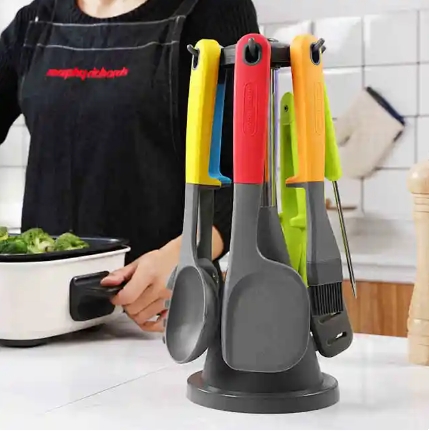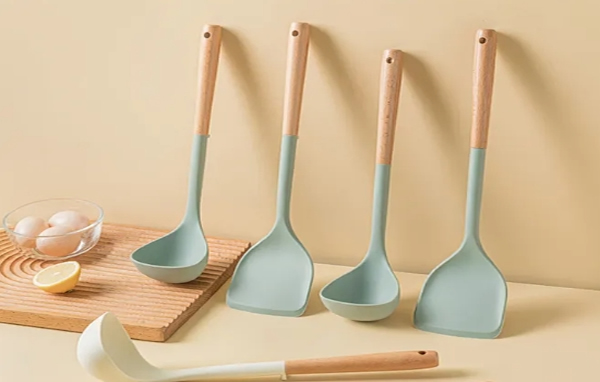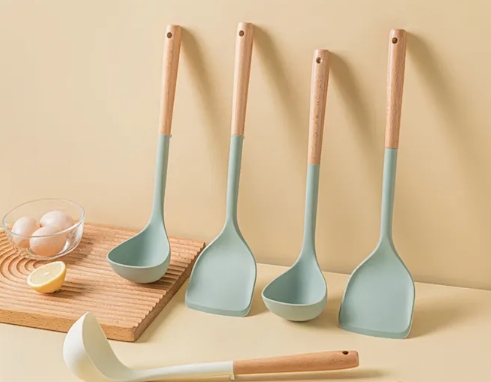Blog
Why Silicone Cooking Utensils Is Taking Over Modern Kitchens
Why Silicone cooking utensils Is Taking Over Modern Kitchens
Today, with the growing awareness of environmental protection and health, the choice of kitchenware is quietly changing. Silicone cooking utensils have quickly occupied the core position of modern kitchens due to their multiple advantages such as environmental protection, durability, safety, and easy cleaning. This article will deeply explore the material advantages, environmental protection properties, diverse uses, cleaning and maintenance methods of silicone cooking utensils, and how to choose high-quality products, providing you with a practical and comprehensive purchase guide, and also providing market insights for companies engaged in the kitchenware industry.
1. Silicone cooking utensils: the "star" material of the kitchen derived from space technology
Silicone was originally an important material in the aerospace industry. It is widely used in kitchenware because of its high temperature resistance, softness and non-toxicity. Silicone is composed of silicon and oxygen, has excellent physical stability, can withstand the temperature range of -40°C to 230°C, and is suitable for freezing and heating environments, truly achieving "one tool for multiple uses". Compared with traditional plastics, silicone is BPA-free, non-toxic and odorless, and is a food contact grade material. According to Healthline's research, high-quality food-grade silicone is safe and harmless to the human body, making it one of the kitchen materials that modern families can choose with confidence.
2. New trend in environmentally friendly kitchens: How can silicone cooking utensils reduce carbon footprint?
As the concept of sustainable development has become popular, the environmental protection characteristics of silicone cooking utensils have become one of the core reasons for their rapid popularity. First, silicone is a recyclable material that is not easy to degrade but can be reshaped and reused at high temperatures to reduce disposable plastic pollution. Secondly, its long service life greatly reduces the frequency of replacement. According to the Plastic Pollution Coalition, ordinary plastic kitchen utensils will break or release harmful substances within a few years, while high-quality silicone cooking utensils can be used for more than 5 years, reducing waste from the source. Furthermore, silicone cooking utensils do not require anti-stick coating or additional grease, avoiding the double burden on the environment and the human body during cooking.

3. Rich variety and wide range of uses: Silicone cooking utensils are "all-rounders" in the kitchen
Silicone cooking utensils cover almost all kitchen tools, from basic spatulas and scrapers to professional-grade baking molds, steamer mats, brushes, sealing lids, etc., to meet the needs of different scenarios. For example:
Silicone spatula: soft and does not damage the pot, suitable for non-stick pans;
Silicone scraper: can accurately scrape the batter or sauce to improve baking efficiency;
Silicone baking mold: light and non-stick, easy to demould, and reusable;
Silicone sealing cover: strong elasticity, good sealing and preservation performance;
These tools are suitable for home kitchens and are widely used by many restaurants and baking workshops, and are gradually replacing the status of plastic and metal tools.
4. How do silicone cooking utensils protect your kitchen health?
Silicone cooking utensils have excellent food contact safety, do not contain harmful ingredients such as BPA (bisphenol A) and plasticizers, and will not release toxic substances at high temperatures. According to the US FDA certification, as long as food-grade silicone is used, it is still safe and reliable under high-temperature cooking. At the same time, because the material is soft, it will not scratch the surface of the pot, nor will it cause food residue, reducing the risk of cross-contamination from the source, and is a particularly recommended choice for families with children and the elderly.

5. Easy to clean and maintain: worry-free and hygienic
Since silicone cooking utensils are not easy to absorb oil, they are easier to clean than traditional materials. Just warm water and a small amount of detergent can quickly clean them. For stubborn cake crumbs on the baking mold, use a soft brush to brush them lightly, which greatly saves kitchen cleaning time. In addition, silicone cooking utensils can be put into the dishwasher for cleaning, and they will not rust or mold, making them an ideal choice for busy family kitchens. It should be noted that in order to extend the service life, direct contact with high-temperature open flames and scratches from sharp objects should be avoided.
6. The unity of aesthetics and practicality in modern kitchens
Today, the kitchen is not only a cooking space, but also a part of the aesthetics of family life. Silicone cooking utensils enhance the overall visual experience of the kitchen due to their colorful appearance design. Soft gray-blue, beige, milky orange, etc. have become the "supporting stars" of modern kitchen design styles. At the same time, its non-slip handle design, humanized hanging holes, and easy storage structure reflect the ultimate pursuit of user experience. According to the Kitchen Trend Report released by Houzz, silicone cooking utensils have become an important accessory for open kitchens and Nordic-style kitchens.
7. How to choose high-quality silicone cooking utensils?
The quality of silicone cooking utensils on the market varies greatly, and consumers should identify them from the following aspects:
Check the certification: choose brands with food-grade certifications such as FDA and LFGB;
Odor detection: high-quality silicone has basically no odor, while inferior products may have a pungent odor;
Observe elasticity and texture: good silicone is shiny and has good resilience;
Pay attention to the temperature range: confirm whether the temperature range marked on the product label meets the cooking needs;
Brand guarantee and after-sales service: choose a reputable manufacturer to provide more stable quality and technical support.

8. Future market potential and business opportunities for silicone cooking utensils
With the global rise of the concept of "low-carbon life", environmentally friendly kitchen products are becoming a new outlet for consumer trends. According to the MarketWatch report, the global silicone cooking utensils market size is expected to exceed US$15 billion by 2030, with an annual compound growth rate of more than 7%. From home users to e-commerce platforms to the gift customization market, the application boundaries of silicone cooking utensils are continuing to expand, and it is a growing category that kitchenware brands, exporters, and gift companies cannot ignore.
9. Summary: Silicone cooking utensils are the "green answer" for the future kitchen
Under the multiple standards of environmental protection, health, efficiency, and beauty, silicone cooking utensils are undoubtedly one of the most recommended products in the modern kitchen. With its comprehensive advantages of environmentally friendly materials, safety performance, multi-functional adaptation, and easy cleaning and maintenance, it provides an ideal choice for everyone who pursues a high-quality life. Whether it is a housewife, a baking enthusiast, or a young person pursuing kitchen aesthetics, silicone cooking utensils will become the "green answer" in the future kitchen.

To learn more about the testing and certification standards for silicone cooking utensils, please refer to:
FDA Guidelines for Food Contact Materials
European LFGB Food Safety Standards
CATEGORIES
LATEST BLOGS
CONTACT US
Contact: Sophie Zheng
Phone: +8613432553325
E-mail: [email protected]
Add: Industrial park Jinjiao, Yangjiang,Guangdong, China

